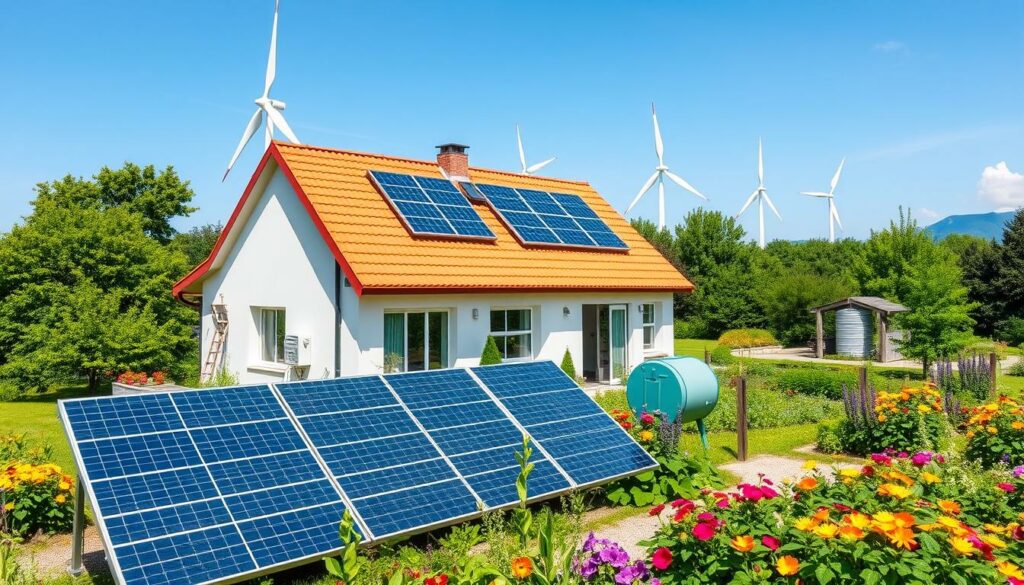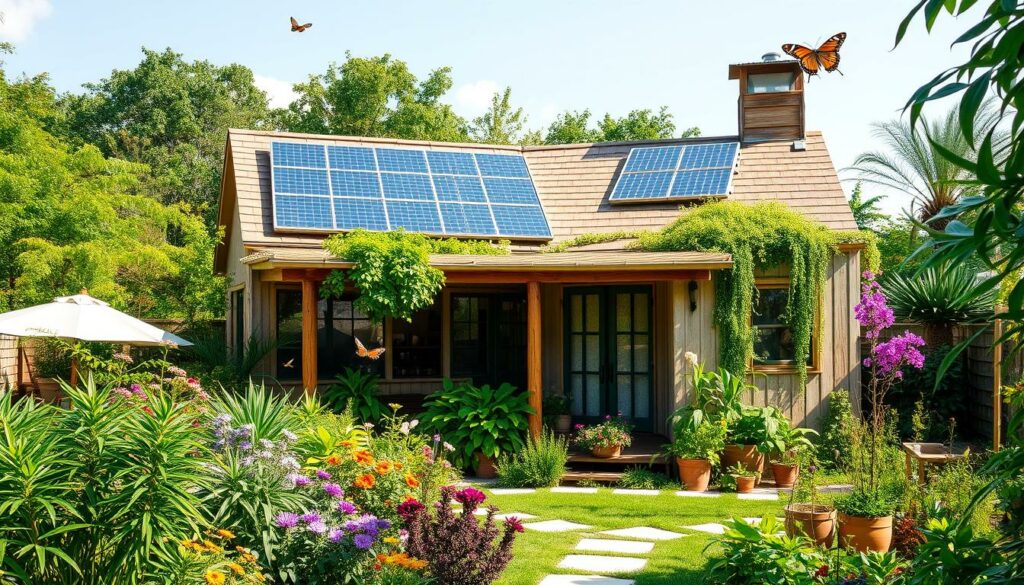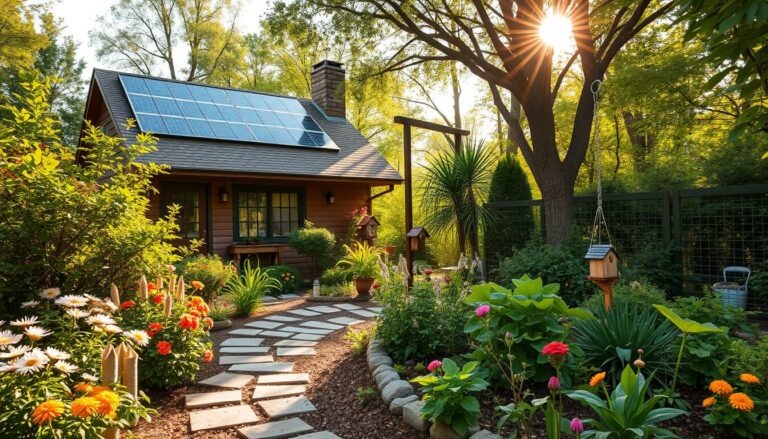The Intergovernmental Panel on Climate Change says we’re facing big problems. Governments and systems haven’t done enough to stop climate change. This has led to over 20 million people being displaced every year.
It’s also making global supply and demand worse. To fight this, we need to act locally. We can do this by making our homes more energy-efficient and using less.
Right now, cities in rich countries are expected to double their emissions by 2050. We need to cut these emissions by two-thirds by 2030. This is to keep our future generations healthy and happy.
Key Takeaways
- Eco-friendly living can help reduce your carbon footprint and environmental impact.
- Adopting sustainable habits, such as reducing single-use plastics and recycling, can make a significant difference.
- Investing in energy-efficient appliances and renewable energy solutions can lower your energy consumption and utility costs.
- Composting food scraps and supporting local food systems can help reduce food waste and promote sustainability.
- Participating in eco-friendly outdoor activities and supporting environmental causes can further contribute to a greener lifestyle.
Reducing Your Carbon Footprint
Your carbon footprint is the total greenhouse gas emissions from your daily life. This includes what you eat and how you travel. By reducing your carbon footprint, you help fight climate change.
Understanding Your Carbon Footprint
Measuring your carbon footprint looks at your lifestyle. This includes your energy use, travel, and what you buy. The food you eat and the products you choose all affect the environment.
The average American’s carbon footprint is about 18.3 tons a year. To keep global warming under 2°C by 2050, we need to get down to 1.87 tons per person. This shows we can do a lot better to protect our planet.
Adopting Sustainable Habits
- Lower your energy use by adjusting your thermostat and using efficient appliances. Turn off lights and electronics when not needed.
- Choose walking, biking, or public transit to cut down on driving emissions.
- Eating more plant-based foods can help, as livestock production is a big source of emissions.
- Plan meals, buy only what you need, and compost food waste to reduce waste.
- Recycle and upcycle to use materials longer and save resources.
- Invest in durable, long-lasting products to save energy and resources for replacements.
By making smart choices and adopting green habits, you can lessen your carbon footprint. Remember, every small action adds up and can make a big difference.
Avoiding Single-Use Plastics
One of the easiest ways to help the environment is by avoiding single-use plastics. The OECD says 91% of plastic isn’t recycled. Most of it ends up in landfills or polluting our world. To fight this, we can make simple changes and use reusable items instead.
Investing in Reusable Products
Choosing reusable over single-use can make a big difference. For example, using a reusable water bottle can save 1,500 plastic bottles a year. That’s $3,000 saved. You can also use reusable coffee mugs, beeswax food wraps, canvas bags, and eco-friendly utensils.
Recycling Plastic Waste
Even though we should avoid single-use plastics, recycling is key. Studies show 90% of foods like beef and tofu have microplastics. These can be harmful if we eat them. Recycling plastic helps reduce pollution in our environment and water.
By choosing reusable items and recycling, we can greatly reduce plastic waste. This helps protect our planet. Recycling plastics we can’t avoid is also crucial to fight plastic pollution.
“The world produced more than 460 million metric tons of plastic in 2019, which doubled the amount produced in 2000.”
| Plastic Waste Facts | Statistics |
|---|---|
| Percentage of plastic that is not recycled | 91% |
| Percentage of plastic that is incinerated | 19% |
| Percentage of commonly consumed proteins containing microplastics | 90% |
| Percentage of plastics consumed that are single-use | 30% |
| Percentage of plastics used in Australia that ends up recycled | 12% |
Recycling and Upcycling
Recycling and upcycling are key to living green. Recycling turns old materials into new ones. The US EPA wants to hit a 50% recycling rate by 2030. Recycling uses 79%-88% less energy than making things from scratch.
Upcycling gives old items a new life. Think before you throw things away. For example, use a plastic strawberry container as a planter or cut up old t-shirts for dish rags. Brands like Adidas and Tommy Hilfiger are making products from recycled materials.
Joining recycling and upcycling efforts helps a lot. It cuts down waste and saves resources. Every small action towards a greener life counts.
| Recycling and Upcycling Statistics | Value |
|---|---|
| US Recycling Rate | Mid-30s range |
| US EPA Recycling Rate Goal by 2030 | 50% |
| Energy and Resource Savings from Recycled Plastic vs. Virgin Material | 79%-88% |
| Global Consumers Expecting Brands to Support Local Social and Environmental Issues | 93% |
| US Adults Basing Purchasing Decisions on Values and Willing to Spend 20% More on Environmentally Sound Products | 68 million |
| US Millennial Internet Users Willing to Pay More for Sustainable Products | 87% |
The recycling and upcycling movement is growing. People want brands to offer eco-friendly choices and to live more sustainably.
“Recycling is the process of converting waste materials into new materials and objects. It is an essential component of modern waste reduction and is the third component of the ‘Reduce, Reuse, Recycle’ waste hierarchy.”
Reducing Food Waste
Food waste is a big problem, with up to 40% of food in the U.S. ending up in landfills. This waste not only leads to methane emissions but also means less food for those who need it. To fight this, we can all take steps to cut down on food waste.
Composting Food Scraps
One great way to reduce food waste is through composting. You can build a compost bin, drop off food scraps, or join a local composting program. This turns waste into soil for your garden, helping our planet and food systems.
| Benefit | Impact |
|---|---|
| Reduces methane emissions from landfills | Equivalent to the impact of 37 million cars per year |
| Provides nutrient-rich soil for gardening | Supports local food production and sustainable landscaping |
| Diverts food waste from landfills | Just redirecting one-third of wasted food can address food scarcity |
By reducing food waste and composting, we can help our planet. We make our food systems more sustainable and reduce the harm caused by food waste.
“Reduced food loss and waste could save the world an estimated $120-$300 billion per year.”
Plant-Based Diet and Local Food Sources
Choosing a plant-based diet helps the planet and supports farming that’s good for the earth. Eating less meat can cut your carbon footprint by up to 73%. This makes it a big step towards fighting climate change.
Raising animals for food is bad for the environment. It uses a lot of land and releases harmful gases. Eating less meat or going plant-based can greatly reduce your impact on the planet.
Benefits of a Plant-Based Diet
A plant-based diet is also good for your health. It can lower the risk of heart disease and other chronic illnesses. Foods like whole grains, fruits, and nuts are key to a healthy diet.
Supporting Local Food Systems
Buying food from local sources is another way to help the environment. Visit farmer’s markets or join a CSA program. It cuts down on food transport emissions and supports your community and sustainable agriculture.
| Food Source | Water Requirement | GHG Emissions |
|---|---|---|
| Beef | 1,900 gallons per lb | Highest |
| Poultry | 500 gallons per lb | Moderate |
| Corn | 110 gallons per lb | Lowest |
| Potatoes | 100 gallons per lb | Lowest |
By changing your diet and supporting local food sources, you can make a big difference. It’s a step towards a more sustainable future.
“It’s estimated that livestock farming uses 30% of the world’s land, equivalent to an area the size of Asia, for raising animals and producing feed crops.”
Conserving Energy at Home
Reducing your home’s energy use is key to a greener lifestyle. Simple changes and smart investments can cut your carbon footprint and lower bills.
Energy-Efficient Appliances and Lighting
Switching to energy-saving appliances and lights is easy. Look for the ENERGY STAR® label on new appliances. They use less power than older models. Also, LED bulbs use 80% less energy than incandescent ones.
Renewable Energy Solutions
Adding solar power to your home cuts down on grid use and emissions. Solar panels are now cheaper and easier to get. They let you make your own clean energy and maybe even sell extra to the grid.
Geothermal heat pumps and wind turbines are other good options. They offer efficient heating, cooling, and power. This reduces your energy use and carbon footprint.
| Energy-Efficient Appliance | Average Energy Savings |
|---|---|
| Refrigerator | 25-50% |
| Washing Machine | 25-50% |
| Dishwasher | 20-50% |
| Air Conditioner | 20-50% |

Using energy-saving appliances, lights, and renewable energy can greatly reduce your home’s energy use. This also saves you money on bills.
Water Conservation Practices
Water is very precious, with only 3 percent being freshwater and less than 1 percent safe for drinking. Saving water is key for humans, animals, and plants. It also cuts down on energy and greenhouse gas emissions needed for water cleaning and distribution. Simple steps at home can make a big difference.
Turning off the faucet while brushing teeth or washing dishes saves water. Shorter showers and using a watering can for gardening also help. Water-efficient appliances, like front-loading washing machines and low-flow shower heads, can cut water use by up to 40 percent.
Fixing leaks is another smart move. Leaks can waste 180 gallons of water a week, or 9,400 gallons a year. Regular checks and repairs can save water and lower bills.
| Water Conservation Technique | Water Savings |
|---|---|
| Front-loading washing machine | Reduces water use by up to 40 gallons per cycle compared to traditional agitator machines |
| Low-flow shower head | Can reduce water flow and pressure, saving up to 2.5 gallons per minute compared to standard shower heads |
| Ultra-low flush (ULF) toilet | Consumes significantly less water per flush than traditional models |
| Drip irrigation system | Provides plants with a consistent water supply, reducing water waste compared to traditional sprinklers |
Using water-efficient fixtures and appliances can cut your water use by at least 20 percent. Native plants, rainwater collection, and covering your pool when not in use also help.
“Water is the driving force of all nature.” – Leonardo da Vinci
Using water wisely is vital for our planet’s future. Simple actions can help save this precious resource and protect our environment.
Offsetting Carbon Emissions
Travel can be fun, but it also affects the environment. Carbon offset schemes help balance our carbon footprints. They support projects like clean energy and reforestation.
These programs are great for reducing travel emissions. They help us make a positive impact on the planet.
Carpooling and Sustainable Transportation
One easy way to lower your carbon footprint is to carpool. Ride-sharing reduces emissions and encourages green travel. Also, using carbon offset programs can offset your travel emissions.
When outdoors, follow Leave No Trace principles. Use eco-friendly products to lessen your impact. By choosing green transportation and activities, you help the environment and enjoy nature.
| Carbon Offset Metric | Cost |
|---|---|
| Neutralizing a year’s gas and electricity use | £45 |
| Offsetting a flight from London to San Francisco | £20 per ticket |
Some question the value of carbon offset projects. But, standards like the Voluntary Gold Standard and Voluntary Carbon Standard ensure quality. By choosing verified projects, we can really help the environment.
“Investing in carbon offset programs can help mitigate the emissions generated by your travels, whether by car, plane, or other modes of transportation.”
Eco-Friendly Living: Simple Steps for a Greener Home
Living an eco-friendly lifestyle is easy. You can make your home greener with simple steps. These steps help reduce your impact on the environment.
Start by using less energy. Switch to LED bulbs to cut down on electricity use. A smart thermostat can also save you money by optimizing your heating and cooling.
Save water too. Use low-flow showerheads and faucets to reduce water waste. Washing clothes in cold water saves energy, especially compared to hot cycles.

Don’t forget about household waste. Composting food scraps can greatly reduce landfill waste. Growing your own vegetables can also cut down on food waste.
Using reusable products is another key step. This includes water bottles and shopping bags. These choices help reduce single-use plastics.
Small changes can make a big difference. By adopting these habits, you help the planet. Every step we take together makes our world greener.
Sustainable Outdoor Activities
Living an eco-friendly life means being mindful of our impact, even outdoors. By following Leave No Trace principles, we can enjoy nature without harming it. This way, our adventures leave the environment as we found it.
Leave No Trace Principles
- Plan Ahead and Prepare: Research your destination, pack the right gear, and know the rules to leave a small mark.
- Travel and Camp on Durable Surfaces: Use trails, campsites, and established areas to protect the environment.
- Dispose of Waste Properly: Take all trash, including food and pet waste, and use proper sanitation.
- Leave What You Find: Enjoy natural wonders and cultural sites without disturbing them.
- Minimize Campfire Impacts: Use a lightweight stove for cooking, and make sure campfires are fully out.
- Respect Wildlife: Keep a safe distance, don’t feed animals, and store food right to avoid attracting them.
- Be Considerate of Other Visitors: Share trails, keep noise down, and think about others’ experiences.
By following these Leave No Trace principles, we can enjoy the outdoors while protecting it. This helps preserve our natural spaces for future generations.
Using eco-friendly gear and supporting eco-tourism are also important. Choose durable, long-lasting items and brands that care about the environment. Join local cleanups or citizen science projects to help the land we love.
“Protecting the environment should be a priority for everyone who enjoys the outdoors. By adhering to sustainable practices, we can ensure that our natural spaces remain pristine for generations to come.”
Supporting Environmental Causes
While doing small things like reducing waste is important, bigger actions are needed too. You can help by voting for leaders who support eco-friendly policies. Also, speak up to your elected officials about environmental issues. Supporting conservation organizations and sustainable businesses is another way to make a difference.
Voting for Eco-Friendly Policies
Voting is a powerful tool for change. Look into the environmental stances of candidates. Choose those who back eco-friendly policies like clean energy and fighting plastic pollution.
Investing in Sustainable Businesses
What you buy can help the planet. Invest in sustainable businesses that care about the environment. Look for companies that use green energy and reduce waste.
| Sustainable Business Practices | Environmental Impact |
|---|---|
| Renewable energy usage | Reduced carbon emissions |
| Responsible waste management | Decreased landfill waste |
| Sustainable product sourcing | Preserving natural resources |
| Ethical labor practices | Improved social and environmental justice |
Supporting sustainable businesses through your choices helps the environment. It moves us towards a greener economy.
Conclusion
Living an eco-friendly life is key to saving our planet. Small changes, like using less plastic and saving water, help a lot. They also cut down our carbon footprint and fight climate change.
Supporting local food and businesses that care about the environment is also important. These actions help make a big difference together.
Starting to live greener might seem hard, but every step counts. By choosing to waste less and support clean energy, you help create a better future. This future is for our planet and all living things.
Choosing an eco-friendly way of life is good for the earth and for you. It can save you money, make you healthier, and give you a sense of purpose. As we all learn more about sustainable practices, it’s time for us to act. Let’s make a positive change in our world.
FAQ
What is the impact of climate change and how can individuals help mitigate it?
How can individuals measure and reduce their carbon footprint?
How can individuals reduce their use of single-use plastics?
What are the benefits of recycling and upcycling?
How can individuals reduce food waste?
What are the benefits of a plant-based diet and supporting local food systems?
How can individuals conserve energy at home?
What are some simple water conservation practices individuals can adopt?
How can individuals offset their carbon emissions from travel?
What are some eco-friendly home improvement options?
How can individuals practice sustainable outdoor activities?
How can individuals support larger-scale environmental change?
Source Links
- 1 . Go Green: 10 Tips for a More Sustainable Lifestyle
- 2. The Ultimate 20 step Guide to Eco-friendly Living | Good Energy
- 3. 35 Ways to Reduce Your Carbon Footprint
- Growing Bonsai: Tips for Miniature Tree Enthusiasts
- Buying Bonsai: Tips for Selecting Your Perfect Tree
- Bonsai Potting: Essential Tips for Tree Care Success
- Bonsai Maintenance: Essential Care for Tiny Trees
- Mastering the Art of Shaping Bonsai: A Beginner’s Guide


